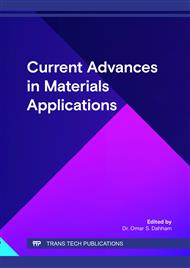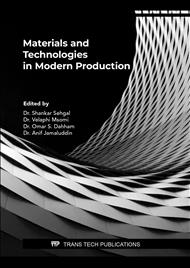[1]
Atyia, M.M., M.G. Mahdy, and M. Abd Elrahman, Production and properties of lightweight concrete incorporating recycled waste crushed clay bricks. Construction and Building Materials, 2021. 304: p.124655.
DOI: 10.1016/j.conbuildmat.2021.124655
Google Scholar
[2]
Yang, J., Q. Du, and Y. Bao, Concrete with recycled concrete aggregate and crushed clay bricks. Construction and Building Materials, 2011. 25(4): pp.1935-1945.
DOI: 10.1016/j.conbuildmat.2010.11.063
Google Scholar
[3]
Zhao, Y., et al., Utilization of waste clay bricks as coarse and fine aggregates for the preparation of lightweight aggregate concrete. Journal of Cleaner Production, 2018. 201: pp.706-715.
DOI: 10.1016/j.jclepro.2018.08.103
Google Scholar
[4]
Aliabdo, A.A., A.-E.M. Abd-Elmoaty, and H.H. Hassan, Utilization of crushed clay brick in concrete industry. Alexandria Engineering Journal, 2014. 53(1): pp.151-168.
DOI: 10.1016/j.aej.2013.12.003
Google Scholar
[5]
S., I.A. and S. Roy, Creep behavior and its prediction for normal strength concrete made from crushed clay bricks as coarse aggregate. Journal of materials in civil engineering, 2012. 24(3): pp.308-314.
DOI: 10.1061/(asce)mt.1943-5533.0000391
Google Scholar
[6]
Debieb, F. and S. Kenai, The use of coarse and fine crushed bricks as aggregate in concrete. Construction and Building Materials, 2008. 22(5): pp.886-893.
DOI: 10.1016/j.conbuildmat.2006.12.013
Google Scholar
[7]
Adamson, M., A. Razmjoo, and A. Poursaee, Durability of concrete incorporating crushed brick as coarse aggregate. Construction and Building Materials, 2015. 94: pp.426-432.
DOI: 10.1016/j.conbuildmat.2015.07.056
Google Scholar
[8]
Chowdhury, S., Effect Of Elevated Temperature On Mechanical Properties Of High Strength Concrete. Vol.2. 2014, Byron Bay, NSW, Australia: 23rd Australasian Conference on Mechanics of Structures and Materials(ACMSM 23.
Google Scholar
[9]
Wongsa, A., et al., Use of crushed clay brick and pumice aggregates in lightweight geopolymer concrete. Construction and Building Materials, 2018. 188: pp.1025-1034.
DOI: 10.1016/j.conbuildmat.2018.08.176
Google Scholar
[10]
Krishna, D.A., R.S. Priyadarsini, and S. Narayanan, Effect of Elevated Temperatures on the Mechanical Properties of Concrete. Procedia Structural Integrity, 2019. 14: pp.384-394.
DOI: 10.1016/j.prostr.2019.05.047
Google Scholar
[11]
BS-EN, BS EN 812-2: Testing aggregates. Methods for determination of density. Pruefung von Zuschlagstoffen. Dichtemessverfahren. (2014).
Google Scholar
[12]
BS-EN, BS EN 12390-3: Testing hardened concrete. Compressive strength of test specimens. (2019).
Google Scholar
[13]
BS-EN, BS EN 12390-5: Testing hardened concrete. Flexural strength of test specimens. 2009: British Standards Institution (BSI).
Google Scholar
[14]
BS-EN, BS EN 12390-7: Testing hardened concrete: Density of hardened concrete. 2009: British Standards Institution (BSI).
Google Scholar
[15]
Khattab, M. and S. Hachemi, Performance of Recycled Aggregate Concrete Made with Waste Refractory Brick. International Journal of Engineering Research in Africa, 2021. 57: pp.99-113.
DOI: 10.4028/www.scientific.net/jera.57.99
Google Scholar
[16]
Sk, A., et al., Experimental Study on Improvement of Compressive Strenght of Concrete Using and Durability of Concrete of Specified Concrete with Adding Waste Spent Fire Brick, Granite and Marble. 2020. 2.
Google Scholar
[17]
Miličević, I., I. Netinger, and D. Bjegović, Recycled clay brick as an aggregate for concrete: Overview. Tehnicki Vjesnik, 2008. 15: pp.35-40.
Google Scholar
[18]
Chowdhury, S., EFFECT OF ELEVATED TEMPERATURE ON MECHANICAL PROPERTIES OF HIGH STRENGTH CONCRETE. (2014).
Google Scholar
[19]
Osuji, S. and U. Ukeme, Effects of Elevated Temperature on Compressive Strength Of Concrete: A Case Study of Grade 40 Concrete. Nigerian Journal of Technology, 2015. 34: p.472.
DOI: 10.4314/njt.v34i3.7
Google Scholar
[20]
Shallal, M. and A. Almusawi, Tests of Residual Shear Transfer Strength of Concrete Exposed to Fire. Archives of Civil Engineering, 2018. 64: pp.187-199.
DOI: 10.2478/ace-2018-0024
Google Scholar



